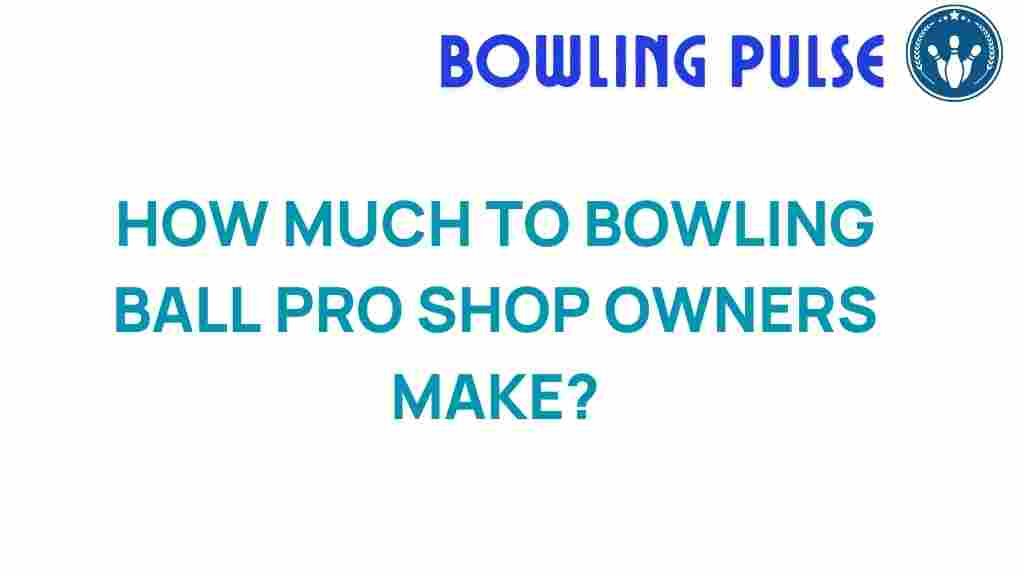Unveiling the Profits: How Much Do Bowling Ball Pro Shop Owners Earn?
The world of sports retail is vast and varied, with each niche offering its own unique opportunities and challenges. One such niche is the bowling ball pro shop industry, which caters to avid bowlers and enthusiasts. In this article, we will delve into the earnings of bowling ball pro shop owners, exploring the factors that influence their revenue and providing industry insights through financial analysis. Whether you’re considering starting a small business in this field or simply curious about the financial aspects of sports retail, this comprehensive guide will illuminate the potential profits of running a bowling ball pro shop.
Understanding the Bowling Ball Pro Shop Industry
Bowling ball pro shops are specialized retail outlets that offer a variety of bowling-related products and services. These shops typically sell:
- Bowling balls
- Bowling shoes
- Bowling bags
- Accessories like wrist supports and towels
- Bowling ball drilling and fitting services
The pro shop serves a critical function in the bowling community by providing not only products but also expertise and personalized services that enhance the bowling experience. As a small business owner in this industry, understanding the potential earnings is essential for success.
Factors Influencing Earnings
The earnings of a bowling ball pro shop owner can vary significantly based on several factors:
- Location: Pro shops situated in areas with a high concentration of bowling alleys or bowling enthusiasts typically enjoy higher foot traffic and sales.
- Market Demand: The demand for bowling products can fluctuate based on trends in the sport, seasonal factors, and local interest.
- Business Model: Retailers who offer additional services, such as coaching or league organization, can generate more revenue.
- Inventory Selection: Carrying a diverse range of high-quality products can attract more customers.
- Marketing Strategies: Effective marketing and community engagement can increase visibility and sales.
Revenue Streams for Pro Shop Owners
Bowling ball pro shop owners can diversify their income through various revenue streams:
1. Direct Sales
The primary revenue source is the direct sale of bowling products. This includes:
- Bowling balls (the most significant portion of sales)
- Bowling shoes
- Accessories
2. Service Fees
Many pro shops offer services such as:
- Drilling and fitting of bowling balls
- Bowling lessons and coaching
- Ball resurfacing and repair
3. League Sponsorships and Events
Pro shops can sponsor local bowling leagues, which not only brings in revenue but also boosts community engagement and brand loyalty.
4. Online Sales
As the retail landscape evolves, many pro shop owners have expanded into e-commerce, providing a broader reach and additional income opportunities.
Financial Analysis: What to Expect in Terms of Earnings
To understand the potential earnings of a bowling ball pro shop, we need to analyze the financial landscape:
- Initial Investment: Starting a pro shop typically requires an initial investment ranging from $50,000 to $150,000. This includes inventory, rental space, equipment, and marketing.
- Monthly Expenses: Owners can expect monthly expenses to range from $2,000 to $10,000, depending on location, rent, utilities, and payroll.
- Annual Revenue: A well-managed pro shop can generate annual revenue between $200,000 and $500,000. However, top-performing shops can exceed this range with effective marketing and customer retention strategies.
Overall, the profit margins in the bowling ball retail business can be attractive, especially for owners who are deeply engaged in the bowling community and understand their customers’ needs.
Step-by-Step Process: Starting Your Bowling Ball Pro Shop
If you’re considering entering the bowling ball pro shop industry, follow these steps:
Step 1: Research Your Market
Understand the demographics of your target audience, local competition, and potential demand.
Step 2: Create a Business Plan
Your business plan should outline your goals, strategies, and financial projections. Make sure to include:
- Market analysis
- Marketing strategies
- Operational plans
- Financial forecasts
Step 3: Secure Financing
Determine how much capital you need and explore financing options such as loans, investors, or personal savings.
Step 4: Find a Suitable Location
Choose a location with high foot traffic and visibility. Consider proximity to bowling alleys and other related businesses.
Step 5: Stock Inventory
Source quality products from reputable suppliers. Ensure you have a diverse range of bowling balls and accessories to attract customers.
Step 6: Set Up Your Shop
Design an inviting store layout that showcases products effectively. Invest in equipment for services like ball drilling and fitting.
Step 7: Market Your Pro Shop
Utilize both online and offline marketing strategies to attract customers. Consider:
- Social media advertising
- Local sponsorships
- Promotions and discounts
Step 8: Engage with the Community
Building relationships within the bowling community can lead to repeat customers and word-of-mouth referrals.
Troubleshooting Tips for Pro Shop Owners
Running a bowling ball pro shop comes with its challenges. Here are some troubleshooting tips:
- Slow Sales: If sales are sluggish, review your marketing strategies and engage with local bowling leagues to increase visibility.
- Inventory Management: Keep a close eye on inventory levels and adjust orders based on sales trends to avoid overstocking or stockouts.
- Customer Engagement: If customer loyalty is lacking, consider implementing a rewards program or hosting events to foster community ties.
Conclusion
In conclusion, owning a bowling ball pro shop can be a fulfilling and profitable venture for those passionate about the sport. While earnings can vary based on multiple factors, with the right strategies, a dedicated approach, and a solid understanding of the industry, pro shop owners can achieve substantial success. As you consider your journey into this small business, remember to leverage your knowledge of the bowling community and adapt to market trends for optimal revenue generation.
For further information on starting a small business in sports retail, you can refer to the U.S. Small Business Administration website. For insights on bowling trends and community events, check out Bowling.com.
This article is in the category Equipment and created by BowlingPulse Team
